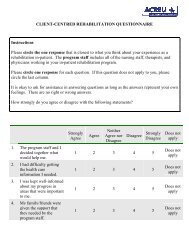Client-Centred Rehabilitation - Arthritis Community Research ...
Client-Centred Rehabilitation - Arthritis Community Research ...
Client-Centred Rehabilitation - Arthritis Community Research ...
Create successful ePaper yourself
Turn your PDF publications into a flip-book with our unique Google optimized e-Paper software.
46<br />
Table 3: System Level Indicators of <strong>Client</strong>-<strong>Centred</strong> Care<br />
CONCEPT DEFINITION<br />
INDICATORS<br />
<strong>Client</strong><br />
involvement in<br />
service planning<br />
<strong>Client</strong> perspectives need to be incorporated<br />
into the planning and provision of services.<br />
This involvement should be meaningful.<br />
• clients as members of<br />
planning groups<br />
Evaluation of<br />
system from<br />
client’s<br />
perspective<br />
Needs to go beyond global ratings of<br />
satisfaction to include explicit feedback<br />
about concrete aspects of the client’s<br />
experience.<br />
• focus groups<br />
• questionnaires<br />
(WASCANA, Picker)<br />
• telephone surveys<br />
• checklist of methods<br />
System-response<br />
to client<br />
feedback<br />
Systems should be in place to respond to<br />
client feedback.<br />
• quality improvement<br />
measures present that<br />
incorporate client feedback.<br />
• what mechanisms are in<br />
place<br />
Accessibility<br />
At the system level, issues of access<br />
include the need for one or more , clear,<br />
identifiable access points into the<br />
rehabilitation system.<br />
• direct access to service<br />
• self-referral<br />
• choice of health provider<br />
• facilitators identifiable<br />
within the system<br />
Coordination<br />
/continuity<br />
The provision of an effective continuum of<br />
service requires high levels of collaboration<br />
not just among professionals on a single<br />
health care team but among multiple<br />
professionals on several teams and often<br />
across organizational boundaries. This<br />
“inter-teamwork” is necessary to minimize<br />
duplication and avoid gaps and<br />
fragmentation in service delivery.<br />
• inter-team communication,<br />
goal setting, decision-making.<br />
• channels of communication<br />
• patterns of referral and<br />
decision-making<br />
• allocation of resources<br />
• boundary crossing functions<br />
of team members








